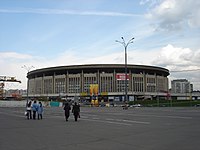Euroleague 2004–05

The Olimpiisky Arena in Moscow hosted the Final Four
|
|
| Season | 2004–05 |
|---|---|
| Champions |
|
| Runners-up |
|
| Third place |
|
| Fourth place |
|
| Teams | 24 |
| Awards | |
| MVP |
|
| Final Four MVP |
|
| Statistical leaders | |
| Index Rating |
24.9
|
| Points |
20.7
|
| Rebounds |
10.6
|
| Assists |
6.2
|
|
← 2003–04
2005–06 →
|
|
The 2004–05 Euroleague was the fifth season of the professional basketball competition for elite clubs throughout Europe, organised by Euroleague Basketball Company, and it was the 48th season of the premier competition for European men's clubs overall. The 2004–05 season featured 24 competing teams, from 13 different countries. The final of the competition was held in Olimpiisky Arena, Moscow, Russia, with the defending champions, Maccabi Elite, defeating Tau Cerámica by a score of 90-78.
The first phase was a regular season, in which the competing teams were drawn into three groups, each containing eight teams. Each team played every other team in its group at home and away, resulting in 14 games for each team in the first stage. The top 5 teams in each group and the best sixth-placed team advanced to the next round. The complete list of tiebreakers was provided in the lead-in to the Regular Season results.
If one or more clubs were level on won-lost record, tiebreakers were applied in the following order:
The surviving teams were divided into four groups of four teams each, and again a round robin system was adopted, resulting in 6 games each, with the two top teams advancing to the quarterfinals. Tiebreakers were identical to those used in the Regular Season.
The draw was held in accordance with Euroleague rules.
The teams were placed into four pools, as follows:
Level 1: The three group winners, plus the top-ranked second-place team
Level 2: The remaining second-place teams, plus the top two third-place teams
Level 3: The remaining third-place team, plus the three fourth-place teams
Level 4: The fifth-place teams, plus the top ranked sixth-place team
Each Top 16 group included one team from each pool. The draw was conducted under the following restrictions:
Each quarterfinal was a best-of-three series between a first-place team in the Top 16 and a second-place team from a different group, with the first-place team receiving home advantage.
...
Wikipedia
